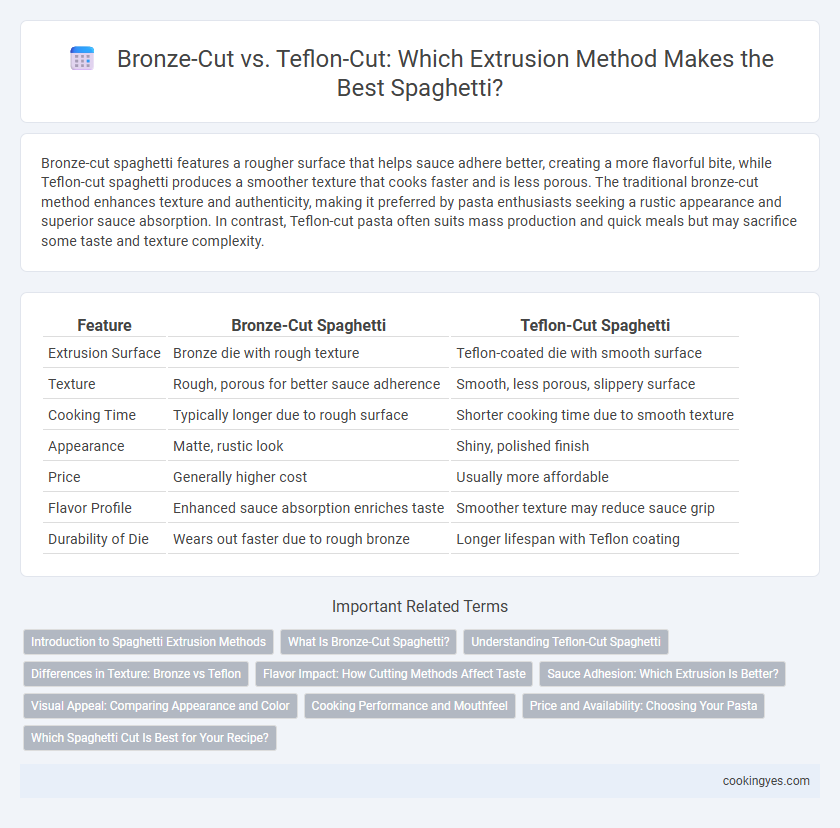Bronze-cut spaghetti features a rougher surface that helps sauce adhere better, creating a more flavorful bite, while Teflon-cut spaghetti produces a smoother texture that cooks faster and is less porous. The traditional bronze-cut method enhances texture and authenticity, making it preferred by pasta enthusiasts seeking a rustic appearance and superior sauce absorption. In contrast, Teflon-cut pasta often suits mass production and quick meals but may sacrifice some taste and texture complexity.
Table of Comparison
| Feature | Bronze-Cut Spaghetti | Teflon-Cut Spaghetti |
|---|---|---|
| Extrusion Surface | Bronze die with rough texture | Teflon-coated die with smooth surface |
| Texture | Rough, porous for better sauce adherence | Smooth, less porous, slippery surface |
| Cooking Time | Typically longer due to rough surface | Shorter cooking time due to smooth texture |
| Appearance | Matte, rustic look | Shiny, polished finish |
| Price | Generally higher cost | Usually more affordable |
| Flavor Profile | Enhanced sauce absorption enriches taste | Smoother texture may reduce sauce grip |
| Durability of Die | Wears out faster due to rough bronze | Longer lifespan with Teflon coating |
Introduction to Spaghetti Extrusion Methods
Bronze-cut spaghetti extrusion involves forcing pasta dough through bronze dies, creating a rough surface that enhances sauce adhesion and contributes to a traditional texture. Teflon-cut extrusion uses non-stick Teflon-coated dies, producing a smoother pasta surface with reduced sticking during production but potentially less sauce grip. The choice between bronze-cut and Teflon-cut impacts the pasta's cooking quality, texture, and how well it holds sauces, influencing consumer preference and culinary applications.
What Is Bronze-Cut Spaghetti?
Bronze-cut spaghetti is made by extruding the dough through bronze dies, which create a rougher, more porous surface that allows sauces to cling better, enhancing flavor absorption. This traditional method results in a slightly thicker, more textured pasta compared to Teflon-cut spaghetti, which is smoother due to the use of non-stick Teflon plates. The bronze-cut process is preferred by many chefs for its superior sauce adherence and artisanal quality.
Understanding Teflon-Cut Spaghetti
Teflon-cut spaghetti extrusion uses a polytetrafluoroethylene (PTFE) die surface that produces a smoother, less porous pasta texture compared to traditional bronze-cut methods. This results in spaghetti with a glossy appearance and reduced sauce adherence, preferred for recipes where a sleek finish is desired. Understanding the impact of Teflon-cut extrusion helps manufacturers tailor pasta characteristics to consumer preferences and cooking performance.
Differences in Texture: Bronze vs Teflon
Bronze-cut spaghetti features a rough, porous surface that allows sauces to cling better, enhancing flavor absorption and mouthfeel, whereas Teflon-cut spaghetti has a smooth, non-porous texture resulting in a slicker finish with less sauce adhesion. The bronze die imparts a traditional, artisanal quality with a chewy bite, while Teflon dies produce a more uniform, glossy pasta that cooks faster but often feels less hearty. Texture differentiation affects culinary applications by influencing sauce pairing and overall dining experience.
Flavor Impact: How Cutting Methods Affect Taste
Bronze-cut spaghetti features a rougher surface texture that enhances sauce adherence, resulting in a richer and more intense flavor experience. Teflon-cut spaghetti, with its smooth finish, tends to produce a more subtle taste as sauces cling less effectively. The extrusion method directly influences the pasta's ability to absorb and meld with sauces, significantly impacting overall flavor perception.
Sauce Adhesion: Which Extrusion Is Better?
Bronze-cut spaghetti has a rougher surface texture that significantly improves sauce adhesion, making it preferred for dishes where sauce clings to the pasta. Teflon-cut spaghetti, with its smoother finish, tends to repel sauce more easily, resulting in less flavorful bites. For optimal sauce retention and enhanced taste experience, bronze-cut extrusion remains the superior choice in spaghetti production.
Visual Appeal: Comparing Appearance and Color
Bronze-cut spaghetti exhibits a rougher, matte surface with a golden yellow hue, enhancing sauce adhesion and creating a rustic, artisanal appearance. Teflon-cut spaghetti features a smooth, glossy finish and a lighter, more uniform color that reflects light, giving it a polished, commercial look. The bronze-cut method is preferred for an authentic visual appeal that highlights texture, while Teflon-cut excels in producing consistent shape and sheen.
Cooking Performance and Mouthfeel
Bronze-cut spaghetti features a rougher surface texture due to the traditional bronze die extrusion, enhancing sauce adherence and creating a chewier mouthfeel preferred in authentic Italian cooking. Teflon-cut spaghetti is extruded through smoother, non-stick dies, resulting in a glossy finish that yields a softer texture and quicker cooking time but may cause sauces to slide off more easily. Cooking performance differs as bronze-cut pasta maintains firmness longer, while Teflon-cut pasta tends to become tender faster, influencing overall dish quality and sensory experience.
Price and Availability: Choosing Your Pasta
Bronze-cut spaghetti features a rougher texture that absorbs sauce better, and it is typically more expensive due to the traditional bronze dies used in its extrusion process. Teflon-cut spaghetti offers a smoother surface and is generally more affordable and widely available, as the non-stick Teflon dies increase production efficiency. When choosing pasta, consider that bronze-cut varieties may cost up to 20-30% more, while Teflon-cut options provide greater accessibility in most markets.
Which Spaghetti Cut Is Best for Your Recipe?
Bronze-cut spaghetti features a rougher texture that holds sauce better, enhancing flavor absorption in traditional Italian dishes, while Teflon-cut spaghetti offers a smoother surface, resulting in a silkier bite ideal for lighter, oil-based recipes. Bronze-cut pasta typically cooks more evenly and retains sauce due to its porous edges, making it preferable for rich, hearty sauces like Bolognese or marinara. For delicate or minimal sauces, Teflon-cut spaghetti provides a refined mouthfeel that complements subtle ingredients without overpowering them.
Bronze-cut vs Teflon-cut for spaghetti extrusion Infographic

 cookingyes.com
cookingyes.com